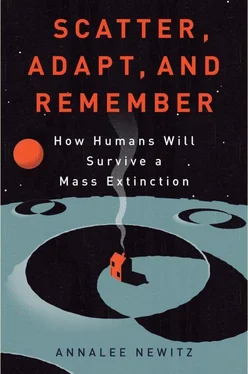A young biologist named Jim Harvey came too, trying to reconcile the behavior of these grays with what he’d seen before. These three were clearly working together to share the airhole and survive, though typically grays are solitary creatures. What’s more, the grays seemed to figure out that the humans jumping up and down on the ice around their hole wanted to help them. Eventually, after forces from both the Soviet Union and the United States got involved in the quest to free the whales, the grays followed an icebreaker out to the open sea. Harvey, now a professor at Moss Landing Marine Laboratories (MLML) on Monterey Bay, has spent the decades since the incident studying marine mammals and other creatures that make a home on the shoreline.
When I visited Harvey at MLML, a cluster of artfully designed, recycled wood buildings built just a few yards from the waters of the bay, the door and windows in his office were thrown open. Outside, seabirds skimmed over the sunny water, and grass furred the sand dunes. Further out to sea, sea lions barked and frolicked in waters where the grays travel twice a year. For decades, Monterey Bay has been a prime spot for gray whale observation—it seems to be a favorite place for the whales. Here they swim very close to shore, making it easy to take population counts and watch them in the wild.
From decades of observation, it’s become clear that the whales don’t choose just one group of companions for the whole migration. “They’ll be with a bunch of animals, forming and changing groups all the time,” Harvey told me. “It’s like being in a bicycle race. You can draft behind [the leader], and it’s nice to be in a group because the guy in front is usually paying attention. I think gray whales do that, too. They trade positions in terms of paying attention.” Harvey had just come in from a run along the water, where he’d followed a narrow trail between MLML, a few other local marine-biology labs, and the undeveloped coastline.
His mind still on the dynamics of racing, Harvey pondered a question that is hotly contested among biologists. How, exactly, do the grays learn to navigate their way along all those thousands of kilometers of coastline? “I’m purely speculating,” he said, “but I think they’re following each other, and somebody else follows them, and they remember it.” When I asked whether they’re communicating directions with sound, too, he shook his head. “I’m sure they don’t talk to each other. They’re just following each other.” Young whales always make the trip with an animal that has gone before.
Still, the trip changes year by year; grays are constantly tweaking their route. Twenty years ago, most of the grays migrated along a path that took them inside the Channel Islands, and closer to the coastal cities of Santa Barbara and Los Angeles. The problem was that they stuck to the shoreline too closely, often following it all the way into the shallow waters where they would become trapped. Grays have had similar problems getting lost in San Francisco Bay and Monterey Bay when they chart their course using what Harvey jokingly referred to as the “keep the shoreline on the left” method. But today, their routes take them outside the Channel Islands, and often outside San Francisco Bay too. “So they’ve figured it out,” Harvey said. They realized that more direct routes away from the coast would be faster and less dangerous, and passed that information on. Grays live for about 50 to 70 years, so these course corrections are taking place within the lifespan of a typical animal.
More recently, Harvey and a National Oceanic and Atmospheric Administration (NOAA) biologist named Wayne Perryman have observed that grays are migrating later in the year, possibly because melting Arctic ice means they have to go farther north to find good grazing grounds. As a result, a faster route south is going to become more desirable to the grays as the years go by—they need to cut corners, as it were. But this longer route is also changing a lot more than their maps to the south. In 2012, observers were surprised to find a female gray and her very young calf swimming in San Francisco Bay. Given the age of the calf, Harvey and Perryman estimated that the gray had probably given birth en route to Mexico. She’d left the Arctic so late in the season that she wasn’t able to get there in time to have her baby. It’s possible that the melting Arctic ice will dramatically change the migratory cycles of the Pacific grays, altering the map that one generation of whales passes along to the next. This is another clue that the grays navigate their migratory routes by learning and memory—if the trip were somehow hardwired into their brains, they wouldn’t be able to shift its parameters every year depending on environmental conditions.
Of course, some grays don’t manage to remember the route quite right—which is why, for example, those three grays got caught in the frozen Arctic in 1988 and had to be rescued by icebreakers. This leads Harvey to another big question. Why should the grays continue to migrate at all, as the thawing Arctic slowly becomes more habitable year-round? “It might get to a point when they don’t have to go, but the reality is that the water is still cold,” he mused. And staying warm in winter Arctic waters takes a lot of energy. He and his colleagues believe it’s worth it for the whales to swim all the way down to Mexico and save energy in the warm water, rather than not swimming but remaining in the cold water.
This also helps to explain why juvenile whales make the journey down to Mexico, even though they are still too young to participate in the mating and calving that goes on in the lagoons. To get the most out of all the blubber they’ve been building up in summer, the young whales need to seek out warmer waters with their elders. But there’s another benefit, too. “Eventually, if you want to be part of the reproductive group, you need to know how to do the migration,” Harvey explained. “They are gaining knowledge, including reproductive knowledge, by making the journey.” It’s likely that the young whales are learning another survival skill along with the route south and then north again. When they arrive in Mexico they’re watching other grays reproduce. How whales learn to mate is a big question mark scientifically, but Harvey said it’s possible that they do it the same way they learn to migrate: through observation and memory.
How the Gray Whale Came Back from Extinction
Unfortunately, memory is no defense against the concerted efforts of ships full of people with harpoons and explosives. The descendants of the whales Scammon hunted still roam the waters of the Pacific coast, but their now-extinct relatives in the Atlantic weren’t as lucky. A large group of grays lived in the Atlantic for thousands of years, migrating from the Arctic to the Mediterranean. But historical evidence suggests that they succumbed to hunters in the eighteenth century. Today, there are only two groups of gray whales left. One, the eastern Pacific, or California-Chukchi group, whose migration we’ve talked about up to this point, contains perhaps 20,000–30,000 individuals. The other is a small, poorly understood group of roughly 200 individuals called the western Pacific or Korean-Okhotsk grays. These whales have a different migration route, along the coast of Asia. In summer they graze along coastlines in the Sea of Okhotsk off the coast of Russia, above Korea and Japan. Their calving grounds are off the coast of Korea.
Both these groups would have gone the way of their Atlantic cousins if it hadn’t been for the rise of conservation groups in California during the early twentieth century. After the establishment of groups like the Sierra Club, which helped protect Yosemite National Park from development in the late nineteenth century, the burgeoning environmentalist movement began to think about protecting animals as well as environments. Even whalers like Scammon noted with unhappiness that the whales were going to be exterminated if hunting kept up at the pace he observed. Often, hunters would simply plow into the mating lagoons and slaughter the vulnerable mothers and calves, destroying the population’s ability to reproduce. Disturbed by the inhumanity of these hunting practices, and aware that grays weren’t particularly valuable as commodities, in 1949 the newly formed International Whaling Commission outlawed the hunting of gray whales. Since that time, many scientists believe that the eastern Pacific population has bounced back to what it might have been before whaling started. Others argue, based on genetic data, that it’s likely the original population before whaling was closer to 90,000 individuals.
Читать дальше






![Аннали Ньюиц - Автономность [litres]](/books/424681/annali-nyuic-avtonomnost-litres-thumb.webp)





